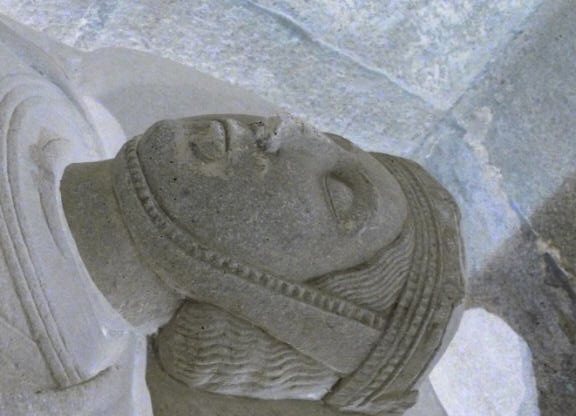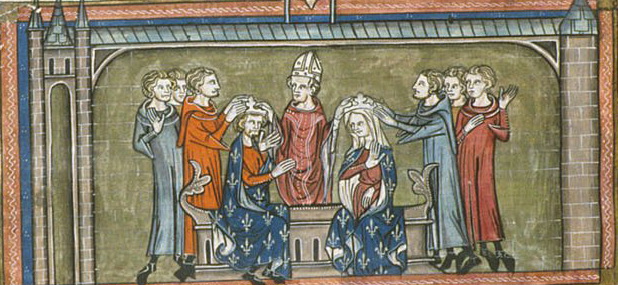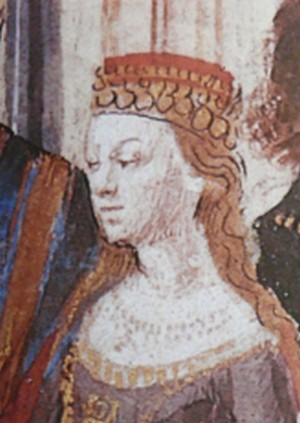|
Joan, Countess Of Ponthieu
Joan of Dammartin (; 1220 – 16 March 1279) was Queen consort of Castile, Queen of Castile and Queen consort of León, León by marriage to Ferdinand III of Castile. She also ruled as Count of Ponthieu, Countess of Ponthieu (1251–1279) and Count of Aumale, Aumale (1237–1279). Her daughter, the English queen Eleanor of Castile, was her successor in Ponthieu. Ferdinand II, Count of Aumale, her son and co-ruler in Aumale, predeceased her, thus she was succeeded by her grandson John I, Count of Aumale. Family Joan was born 1220. She was the eldest daughter of Simon of Dammartin, Count of Ponthieu (1180- 21 September 1239), and his wife Marie of Ponthieu, Countess of Montreuil (17 April 1199 – 1251). Her paternal grandparents were Alberic III of Dammartin, Alberic III, Count of Dammartin, and Mahaut de Clermont, daughter of Renaud II, Count of Clermont-en-Beauvaisis, Renaud de Clermont, Count of Clermont-en-Beauvaisis, and Clémence de Bar. Her maternal grandparents were Wi ... [...More Info...] [...Related Items...] OR: [Wikipedia] [Google] [Baidu] |
Queen Consort Of Castile
This is a list of the queens consort and kings consort of the Kingdom of Castile, and later, Crown of Castile. ''It is, in part, a continuation of the list of Asturian royal consorts and the list of Leonese royal consorts''. Countesses Banu Mamaduna Banu Ansúrez Banu Mamaduna Queens and Kings House of Jiménez House of Ivrea House of Trastámara House of Habsburg At 1556, the union of the Spanish kingdoms is generally called Spain and Mary I of England (second wife of Philip II of Spain, Philip II) is listed as the first Royal Consorts of Spain, Queen consort of Spain. See also *List of Castilian monarchs *List of Aragonese consorts *List of Asturian consorts *List of Galician consorts *List of Hispanic consorts *List of Leonese consorts *List of Navarrese consorts *List of Spanish consorts Notes Sources * * {{DEFAULTSORT:List Of Castilian Consorts Queens consort of Castile, Lists of queens, Castilian Queen Consorts, List of Lists of countesses ... [...More Info...] [...Related Items...] OR: [Wikipedia] [Google] [Baidu] |
William IV Of Ponthieu
William IV Talvas (1179 – 4 October 1221) was William III, Count of Ponthieu and William IV (of the house of Belleme/Montgomery). He was Count of Ponthieu, ruler of a small province in northern France that fell under the suzerainty of the dukes of Normandy (later also kings of England) since at least the mid 11th century. Life William was the son of John I, Count of Ponthieu and Beatrice de St Pol. His father John I, Count of Ponthieu (died 1191) was the son of Guy II, Count of Ponthieu (who died on the Second Crusade 1147). William was an army commander in the Anglo-French War (1202–1214) and one of the commanders of the left wing of the French army in the Battle of Bouvines in 1214. William also participated in the Albigensian Crusade, particularly in the siege of Termes in 1210, where he and the count of Dreux informed Simon de Montfort they had fulfilled their indulgences and were departing the siege. Marriage William was married on 20 August 1195 to Alys, Counte ... [...More Info...] [...Related Items...] OR: [Wikipedia] [Google] [Baidu] |
Elisabeth Of Hohenstaufen
Elisabeth of Swabia (renamed Beatrice; March/May 1205 – 5 November 1235), was a member of the House of Hohenstaufen who became Queen of Castile and Leon by marriage to Ferdinand III. Born in Nürnberg, Elisabeth was the fourth daughter of Philip of Swabia, King of Germany, and Irene Angelina, daughter of Emperor Isaac II Angelos of the Byzantine Empire.(ES)''Acercamiento Mutuo de Espana y Alemania'', Jaime Ferreiro Alemparte, ''España y Europa, un pasado jurídico común'', ed. Antonio Pérez Martín, (Cometa S.A., 1986), 181. Elisabeth's father was murdered on 21 June 1208, and her mother died from childbirth complications on 27 August. Elisabeth and her sisters were placed under the guardianship of their cousin, King Frederick Roger of Sicily, who arranged the marriage of Elisabeth and King Ferdinand III of Castile. The marriage ceremony between Elisabeth and Ferdinand III was celebrated on 30 November 1219 in the city of Burgos. In Castile, she assumed the name Beat ... [...More Info...] [...Related Items...] OR: [Wikipedia] [Google] [Baidu] |
Coat Of Arms Of Jeanne Of Dammartin As Queen Of Castile
A coat is typically an outer garment for the upper body, worn by any gender for warmth or fashion. Coats typically have long sleeves and are open down the front, and closing by means of buttons, zippers, hook-and-loop fasteners (AKA velcro), toggles, a belt, or a combination of some of these. Other possible features include collars, shoulder straps, and hoods. Etymology ''Coat'' is one of the earliest clothing category words in English, attested as far back as the early Middle Ages. (''See also'' Clothing terminology.) The Oxford English Dictionary traces ''coat'' in its modern meaning to , when it was written ''cote'' or ''cotte''. The word coat stems from Old French and then -4; we might wonder whether there's a point at which it's appropriate to talk of the beginnings of French, that is, when it wa ... and then Latin ''cottus.'' It originates from the Proto-Indo-European language">Proto-Indo-European word for woolen clothes. An early use of ''coat'' in English is Mail ... [...More Info...] [...Related Items...] OR: [Wikipedia] [Google] [Baidu] |
Eleanor Of Provence
Eleanor of Provence ( 1223 – 24/25 June 1291) was a Provence, Provençal noblewoman who became List of English royal consorts, Queen of England as the wife of King Henry III of England, Henry III from 1236 until his death in 1272. She served as regent of England during the absence of her spouse in France in 1253. Although Eleanor was completely devoted to her husband and staunchly defended him against the rebel Simon de Montfort, 6th Earl of Leicester, she was very unpopular among the Londoners. This was because she had brought many relatives with her to England in her retinue; these were known as "the Savoyards" (her mother was from Savoy), and, as Londoners saw it, these foreigners were given influential positions in the government and realm to lord over them. On one occasion, Eleanor's barge was attacked by angry Londoners who pelted her with stones, mud, pieces of paving, rotten eggs and vegetables. Eleanor had five children, including the future King Edward I of England. ... [...More Info...] [...Related Items...] OR: [Wikipedia] [Google] [Baidu] |
Louis IX Of France
Louis IX (25 April 1214 – 25 August 1270), also known as Saint Louis, was King of France from 1226 until his death in 1270. He is widely recognized as the most distinguished of the Direct Capetians. Following the death of his father, Louis VIII, he was Coronation of the French monarch, crowned in Reims at the age of 12. His mother, Blanche of Castile, effectively ruled the kingdom as regent until he came of age, and continued to serve as his trusted adviser until her death. During his formative years, Blanche successfully confronted rebellious vassals and championed the Capetian cause in the Albigensian Crusade, which had been ongoing for the past two decades. As an adult, Louis IX grappled with persistent conflicts involving some of the most influential nobles in his kingdom, including Hugh X of Lusignan and Peter I of Brittany. Concurrently, England's Henry III of England, Henry III sought to reclaim the Angevin Empire, Angevin continental holdings, only to be decisively def ... [...More Info...] [...Related Items...] OR: [Wikipedia] [Google] [Baidu] |
Louis VIII Of France
Louis VIII (5 September 1187 8 November 1226), nicknamed The Lion (), was King of France from 1223 to 1226. As a prince, he invaded Kingdom of England, England on 21 May 1216 and was Excommunication in the Catholic Church, excommunicated by a papal legate on 29 May 1216. On 2 June 1216, Louis was proclaimed "King of England" by rebellious barons in London, though never crowned. With the assistance of allies in England and Scotland he gained control of approximately one third of the English kingdom and part of Southern Wales. He was eventually defeated by English loyalists and those barons who swapped sides following the death of King John of England, King John. After the Treaty of Lambeth, he was paid 10,000 mark (currency), marks, pledged never to invade England again, and was absolved of his excommunication. As prince and fulfilling his father's crusading vow, Louis led forces during the Albigensian Crusade in support of Simon de Montfort, 5th Earl of Leicester, Simon de Mo ... [...More Info...] [...Related Items...] OR: [Wikipedia] [Google] [Baidu] |
Plantagenets
The House of Plantagenet ( /plænˈtædʒənət/ ''plan-TAJ-ə-nət'') was a royal house which originated from the French county of Anjou. The name Plantagenet is used by modern historians to identify four distinct royal houses: the Angevins, who were also counts of Anjou; the main line of the Plantagenets following the loss of Anjou; and the Houses of Lancaster and York, two of the Plantagenets’ cadet branches. The family held the English throne from 1154, with the accession of Henry II, until 1485, when Richard III died in battle. England was transformed under the Plantagenets, although only partly intentionally. The Plantagenet kings were often forced to negotiate compromises such as Magna Carta, which constrained royal power in return for financial and military support. The king was no longer just the most powerful man in the nation, holding the prerogative of judgement, feudal tribute and warfare, but had defined duties to the realm, underpinned by a sophisticated j ... [...More Info...] [...Related Items...] OR: [Wikipedia] [Google] [Baidu] |
John Of England
John (24 December 1166 – 19 October 1216) was King of England from 1199 until his death in 1216. He lost the Duchy of Normandy and most of his other French lands to King Philip II of France, resulting in the collapse of the Angevin Empire and contributing to the subsequent growth in power of the French Capetian dynasty during the 13th century. The First Barons' War, baronial revolt at the end of John's reign led to the sealing of Magna Carta, a document considered a foundational milestone in English and later British constitution of the United Kingdom, constitutional history. John was the youngest son of King Henry II of England and Duchess Eleanor of Aquitaine. He was nicknamed John Lackland () because, as a younger son, he was not expected to inherit significant lands. He became Henry's favourite child following the failed revolt of 1173–1174 by his brothers Henry the Young King, Richard I of England, Richard, and Geoffrey II, Duke of Brittany, Geoffrey against their ... [...More Info...] [...Related Items...] OR: [Wikipedia] [Google] [Baidu] |
Philip Augustus
Philip II (21 August 1165 – 14 July 1223), also known as Philip Augustus (), was King of France from 1180 to 1223. His predecessors had been known as kings of the Franks (Latin: ''rex Francorum''), but from 1190 onward, Philip became the first French monarch to style himself "King of France" (''rex Francie''). The son of King Louis VII and his third wife, Adela of Champagne, he was originally nicknamed () because he was a first son and born late in his father's life. Philip was given the epithet "Augustus" by the chronicler Rigord for having extended the crown lands of France so remarkably. After decades of conflicts with the House of Plantagenet, Philip succeeded in putting an end to the Angevin Empire by defeating a coalition of his rivals at the Battle of Bouvines in 1214. This victory would have a lasting impact on western European politics: the authority of the French king became unchallenged, while John, King of England, was forced by his barons to assent to Magna Car ... [...More Info...] [...Related Items...] OR: [Wikipedia] [Google] [Baidu] |
Henry III Of England
Henry III (1 October 1207 – 16 November 1272), also known as Henry of Winchester, was King of England, Lord of Ireland, and Duke of Aquitaine from 1216 until his death in 1272. The son of John, King of England, King John and Isabella of Angoulême, Henry assumed the throne when he was only nine in the middle of the First Barons' War. Cardinal Guala Bicchieri declared the war against the rebel barons to be a religious crusade and Henry's forces, led by William Marshal, defeated the rebels at the battles of Battle of Lincoln (1217), Lincoln and Battle of Sandwich (1217), Sandwich in 1217. Henry promised to abide by the Magna Carta#Great Charter of 1225, Great Charter of 1225, a later version of the 1215 Magna Carta, which limited royal power and protected the rights of the major barons. Henry's early reign was dominated first by William Marshal, and after his death in 1219 by the magnate Hubert de Burgh. In 1230, the King attempted to reconquer the Angevin Empire, provinces of ... [...More Info...] [...Related Items...] OR: [Wikipedia] [Google] [Baidu] |







